- Home
- Editorial
- News
- Practice Guidelines
- Anesthesiology Guidelines
- Cancer Guidelines
- Cardiac Sciences Guidelines
- Critical Care Guidelines
- Dentistry Guidelines
- Dermatology Guidelines
- Diabetes and Endo Guidelines
- Diagnostics Guidelines
- ENT Guidelines
- Featured Practice Guidelines
- Gastroenterology Guidelines
- Geriatrics Guidelines
- Medicine Guidelines
- Nephrology Guidelines
- Neurosciences Guidelines
- Obs and Gynae Guidelines
- Ophthalmology Guidelines
- Orthopaedics Guidelines
- Paediatrics Guidelines
- Psychiatry Guidelines
- Pulmonology Guidelines
- Radiology Guidelines
- Surgery Guidelines
- Urology Guidelines
New modality to Detect Blood Clots With Simple At-Home Test

Researchers have developed a simple paper-based test that can help patients with blood clotting disorders perform regular tests from the convenience of their homes.
While blood clotting due to cut or injury can be normal, sometimes a blood clot forms within a blood vessel that has not been injured or cut. For patients at risk for blood clots, strokes and hypertension, routine lab tests to monitor blood-thinning medications can be frequent, costly and painful.
Patients with cardiovascular disease, hypertension, atrial fibrillation, congestive heart failure, kidney disease and others who are at risk for blood clotting are especially vulnerable when blood-thinning medication levels get too weak or too strong. This imbalance can quickly lead to ischemic (clotting) or hemorrhagic (bleeding) strokes if not detected in time.
"We have developed a blood screening device for patients on medications like Coumadin, Warfarin or other blood thinners who need to monitor their blood-clotting levels on a regular basis," said Andrew Steckl, professor at University of Cincinnati in the US. "Patients can soon monitor their blood coagulation characteristics from home quickly and painlessly before making needless trips to the lab or hospital," Steckl noted.
Using nanofiber membranes inside paper-based porous materials housed within a plastic cassette, the researchers can quickly reveal the level of the blood's ability to clot, and all from the convenience of the patient's living room with a simple finger stick to draw a drop of blood. Slight changes in the level of coagulation properties will occur normally depending on certain food intake and overall health conditions, Steckl said.
But a major change in levels immediately shows up on the paper-based test stick resulting in clotting patterns registering on one end of the spectrum or the other and will put up a red flag before any physiological trouble starts, the study said.
The findings were presented at the eighth international conference on porous media and annual meeting of the International Society for Porous Media in Cincinnati, Ohio.

Disclaimer: This site is primarily intended for healthcare professionals. Any content/information on this website does not replace the advice of medical and/or health professionals and should not be construed as medical/diagnostic advice/endorsement or prescription. Use of this site is subject to our terms of use, privacy policy, advertisement policy. © 2020 Minerva Medical Treatment Pvt Ltd